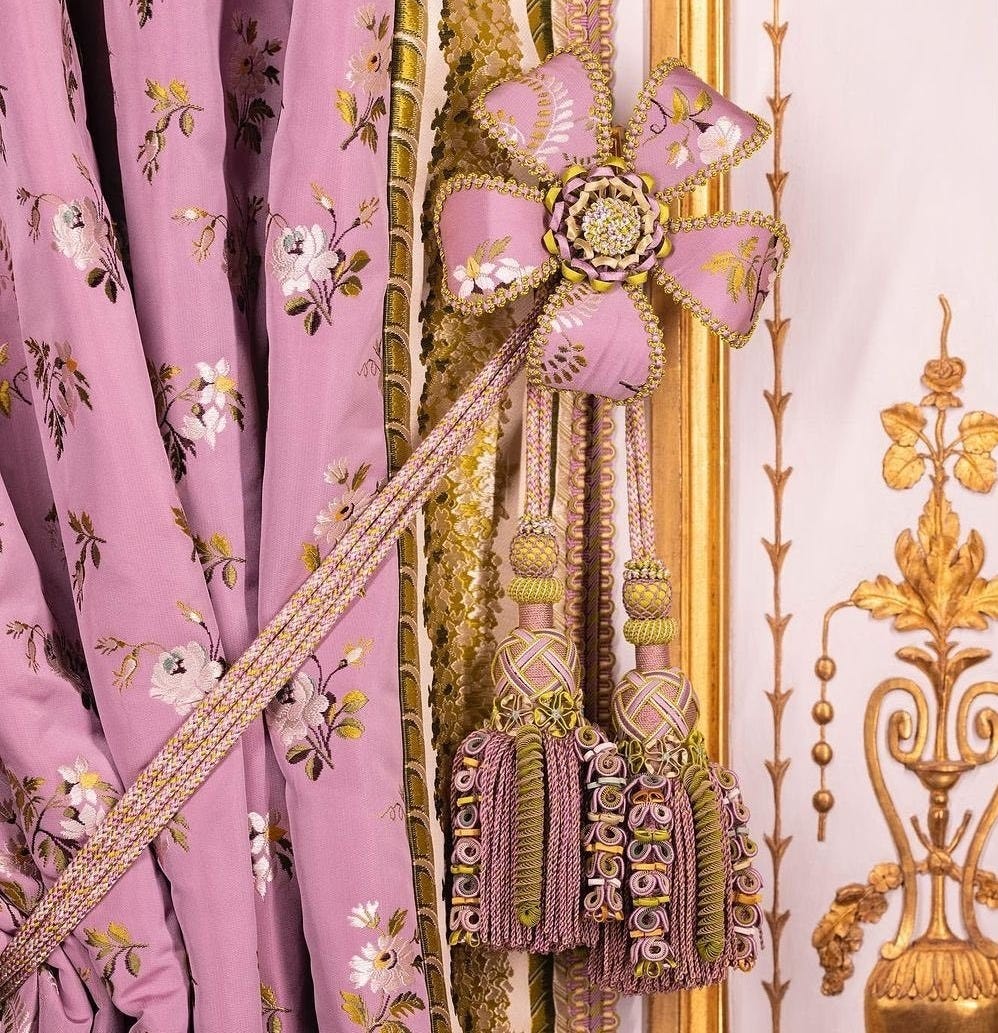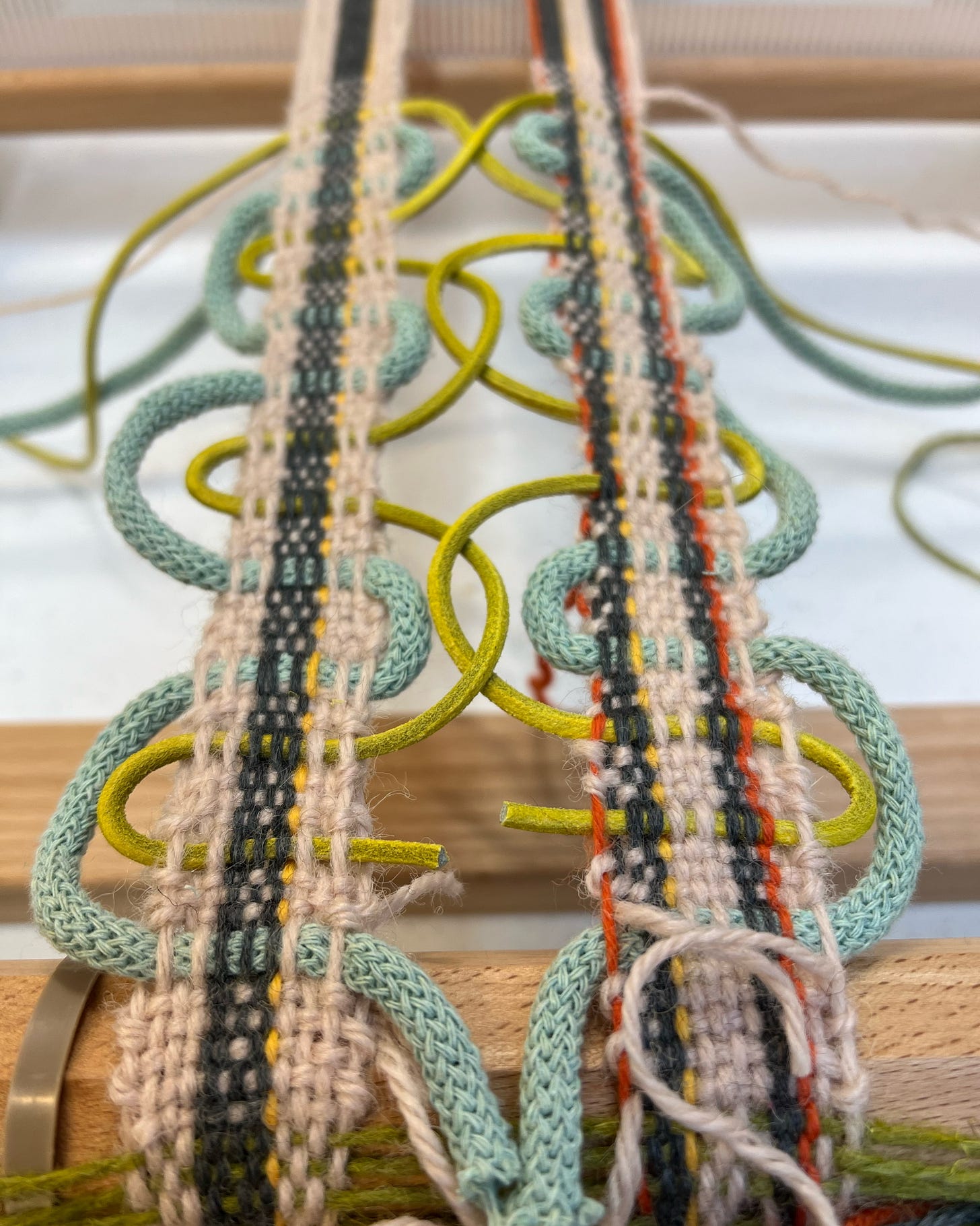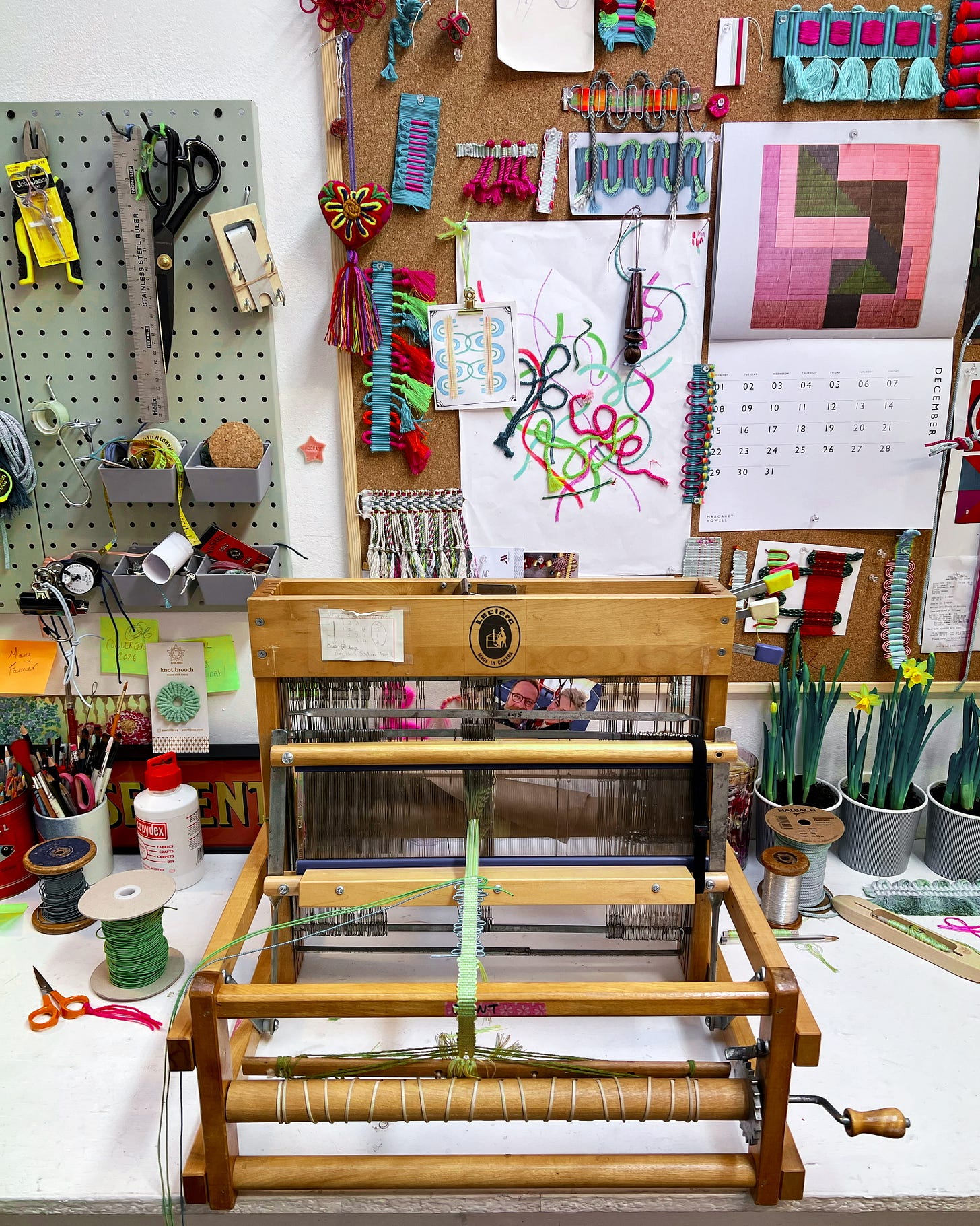It’s a clear Thursday morning when I set off by foot down a busy road somewhere in South London. I am surrounded by hurried people making their way to work, running for buses, herding their kids to the school gates, beginning the routine activities of just another day. This is not my usual commute, nor for me is it just another day. This is the start of a grand adventure, miles away from my home in Belfast and my studio on the Woodstock Road, with only google maps as my compass. I take a deep breath, the air is cold but I am warmed by the bright January sunshine and filled with a rush of anticipation for what lies ahead.
My destination is the studio of passementerie artist, Elizabeth Ashdown. I am on my way to realise something I have been looking forward to for many months. In 2024 I was awarded a bursary by the Heritage Crafts Association to support my training in the endangered craft skills of passementerie alongside the specialist skills of kumihimo and ply-split braiding. This first session with Elizabeth is planned to be 3 days of 1:1 training of on-loom techniques in her London studio. It’s an incredible opportunity as Elizabeth is one of only 5 professional passementerie hand weavers working in the UK today.
You might not know what passementerie is, and you would not be alone, it is an endangered craft after all. Elizabeth describes it as a “mysterious, enigmatic, and underappreciated area of textile artistry…. Passementerie is an umbrella term for a vast range of different handmaking techniques, processes, and crafts. Broadly speaking, passementerie is split into three areas: weaving, cord spinning, and tassel and rosette making.” 1 In short it is the art of making elaborate trimmings, traditionally used to adorn garments and furnishings. If you are struggling to pronounce it then join the club, it took me a few goes to get it right. The term is of french origin so you can try it with your best french accent or just a bog standard English pronunciation, which would sound something like this: (pass-a-mon-tray)
Like so many textile crafts, my own specialist craft of macramé included, it is difficult to pin point a specific origin as the practice has simultaneously developed into unique identities throughout the many cultures of the world. Early painted portraits of the European aristocracy, adorned with luxurious trims, lace and textiles is evidence of how handcrafted embellishments came to embody wealth and significance. With demand on the rise, The Guild of Passementiers was created in sixteenth century France. Prior to the use of the term in seventeenth century Britain, a practitioner of one of the crafts involved in making trims would have been called lace-man or woman, fringe maker, frog maker or silk-woman2. Throughout Europe and Britain, Passementerie was a symbol of status, commissioned to adorn castles, palaces and places of worship as well as the extravagant clothing of the most influential members of society, Marie Antoinette and Queen Elizabeth I to name a few. The industry was thriving and continued to do so right up to the Victorian Era, but the details of these specialised skills were kept under lock and key by the guilds, ateliers and family run workshops that produced these decadent trims, passed down from maker to maker through the generations. Consequently very little written instruction exists about how the designs were created.

The handful of passementerie makers that exist in the UK today have honed their skills with painstaking archival research, restoration of historical samples, the generosity of previous generations of makers and by adapting traditional processes with modern materials and aesthetics. According to The Heritage Crafts Association, a UK charity that advocates for traditional heritage crafts, passementerie is classified as an endangered craft. This means that there are “sufficient craftspeople to pass on skills to the next generation, but for which there are serious concerns about their ongoing viability. This may include crafts with a shrinking market share, an ageing demographic or crafts with a declining number of practitioners”3 The list of practitioners is small, and only recently Brian Turner has retired leaving 5 individual makers, and 2 businesses remaining: Anna Crutchley, Wendy Cushing, Jessica Light, Clare Hedges, Elizabeth Ashdown, Heritage Trimmings and Trimmings by Design.
On that auspicious Thursday morning I nervously arrive at my destination, a blue door at the entrance of an old Victorian storehouse turned artist studios. After all the initial introductions Libby welcomes me into her space, its bright and bijou with a giant loom named Bertha in one corner. The walls are bedecked with samples, swatches and sketches in the vivid colourways that are the core of her signature style. While Libby’s work is deeply rooted in tradition, its her contemporary art-based approach that hooked me in and led me down this path to passementerie. As I leaf through her collection of samples I’m like a kid in a candy shop, overwhelmed by the intricacies and seemingly infinite variations of what Libby has created, alongside her stunning collection of heritage samples. I’m eager to get started and already 10 steps ahead in what my mind can imagine, but I must not get ahead of myself, there is so much to learn and this is slow craft after all.
Over the course of 3 days I am immersed in a whole new world. I am not an experienced weaver so we start off with the basics, weaving on an Ashford Rigid Heddle Loom with a 15dpi reed, the same bit of kit I have waiting for me to set up back in the studio. There is all the technical stuff about sett, dpi and epi that I jot down notes on, knowing full well I will have to do plenty more reading on this later. We warp up the loom using only a narrow warp width as is standard with typical passementerie trims. The terminology is all unfamiliar territory but there is cross over with my existing skill set when it comes to measurements and tension and in fact the use of some basic knots, a language I understand fluently.
The rigid heddle loom is designed for a weft face weave and so I practice a section of a simple plain weave, passing the pick and shuttle back and forth across the warp until I get the hang of the process, and the loom. What comes next I can only describe as taking a line for a walk. The process of creating a decorative weft of interwoven picots (small loops) and scallops (large loops) to the weave and creating a selvage edge pattern which forms a fundamental element to the art of woven passmenterie. From there we explore adding warp stripes and more complex patterns of interwoven decorative wefts using a double warp that forms a ribbed or ridged pattern called a crête (translation from French is ridge or crest) and the adding of fringe and tassels. It’s a hypnotic and addictive process that speaks to the side of my brain that understands maths best as visual patterns. I am totally hooked!
On day three I am introduced to Dorothy, the beautiful Leclerc shaft loom that Libby purchased second hand while she was briefly living in Canada. The Canadian connection is a nice surprise and I instantly feel an affinity to this beautiful bit of kit. Libby walks me through the ins and outs of using a shaft loom, which is what she uses to create her signature warp faced or cramped weave designs. The shaft loom can be warped with much finer strands at a higher dpi than the ridgid heddle loom which allows for this cramped weave (here’s all the techie stuff again). I am also provided with some hand spun gimp cord that Libby procured during her time training with Brian Turner before he retired and closed down his passementerie workshop. The process of creating the scallops and picots is the same but the shaft loom weave is tighter and allows me to blend the colours of the warp thread with a beautiful strié (variegated stripe) The addition of the gimp has a wonderful rigid structure that amplifies my picots and scallops.
It is wonderfully generous act to invite a total stranger into your making space and share your knowledge and skills. It’s the mark of true passion for the survival of the craft so that instead of keeping these endangered skills closely guarded, they are passed on to new generations of makers. For me it has planted a seed and given me a chance to not only learn the basic skills of the craft but to also pick Libby’s brain about other aspects of her practice like her QEST scholarship and how she balances the different parts of her business. I am so thankful for her time and looking forward to visiting her again later on in the year for some off loom training. In the meantime I’ll be setting up my new loom and cracking on with some weaving practice in my own studio.
If you’d like to see some of Libby’s work in person she’ll be exhibiting and giving a talk at Collect 2025 in Somerset House, London. I’ll be paying a flying visit en route to the next leg of my training in West Dean College, I hope you’ll stay tuned in to see how I get on.
Passementerie: Handcrafting Contemporary Trimmings, Fringes, Tassels and More by Elizabeth Ashdown / page 10
Passementerie: Handcrafting Contemporary Trimmings, Fringes, Tassels and More by Elizabeth Ashdown / page 14
Heritage Crafts Association / www.heritagecrafts.org.uk / Categories of Risk / The Heritage Crafts Red List









So intriguing Alison, and the weaves are so beautiful!